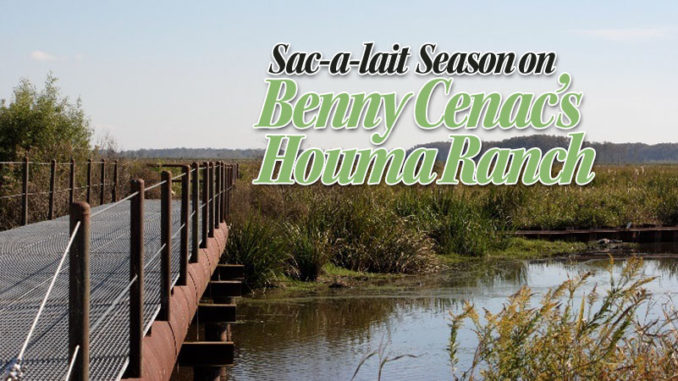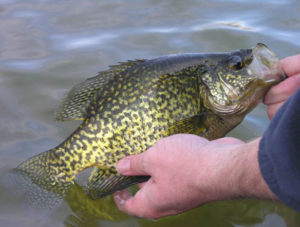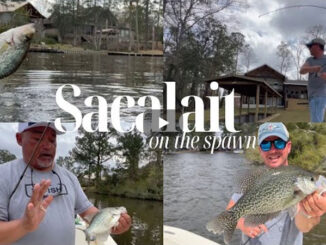
![]() “Hey, they’re gonna see me comin’ before the sun dries the mornin’ dew. Hey, you know I can’t wait to go sac-a-lait fishin’ down on whiskey bayou.”
“Hey, they’re gonna see me comin’ before the sun dries the mornin’ dew. Hey, you know I can’t wait to go sac-a-lait fishin’ down on whiskey bayou.”
On Benny Cenac’s Houma ranch, Sac-au-lait Fishing, a song by Tab Benoit, comes to life and captures the emotions of many a fisherman with dreams of spending days on the dregs of the swamps catching beacoups of their official state freshwater fish: the sac-a-lait.
Known to the rest of the world as either white or black “crappie,” Southern Louisianans use ‘sac-a-lait’ – the French term for ‘sack of milk’ – to describe the flat-bodied sunfish. Sac-a-lait are also called paper mouth, bridge perch, slabs, and speckled perch throughout other areas of the state. Crappie (pronounced crop-ee) are mild-tasting, white-fleshed, flaky panfish eagerly devoured across North America—and found in the 52,000 acres of freshwater marsh and fields of Benny Cenac’s Golden Ranch Farms, the largest privately-owned refuge in the state.
Louisiana is home to both white and black crappie, though white crappie are more prevalent in the Gulf Coast region. Sac-a-lait fisherman are intensely competitive and secretive by nature, often hiding where their best spots are. They spend their days stealthily seeking the right combination of location, weather, tides, and the perfect bait to entice the tricky fish to make a mistake.
The two types can be distinguished by their dot distributions—white crappie have their dots distributed into stripes on their side, whereas black crappie are more compressed with more evenly-dispersed dots. The fish so immortalized by Tab Benoit’s blues song were likely white crappie – the embodiment of the Cajun ‘sac-a-lait’ moniker – because black sac-a-lait prefer clearer, still lake or back-swamp areas instead of the shadier, murkier flowing waters inhabited by their white cousins.
Sac-a-lait fish make bowl-shaped nests in sandier, shallower areas during the springtime spawning season in spring, but these popular fish can be caught any time of year. Some fishermen will even use old Christmas trees to create a habitat for the fish to thrive in. They have been known to collect all the Christmas trees they can find after the Christmas season and hide them in their section of the lake. It’s a win-win-win. The fishermen get more fish, the fish get a nicer habitat, and it’s a great way of recycling the trees.
Benny Cenac, Houma-based businessman, mariner, and angler conserving sac-a-lait

Benny Cenac’s Houma Golden Ranch Farms is situated on the Atchafalaya Basin – the largest freshwater swamp in the nation – also hailed as the best crappie fishing on the Gulf Coast. Travelers on I-10 can’t help but notice nearly a million acres of stumps, logs, and trees on the Basin—a likely cover for the swarms of sac-a-lait below. In fact, Benny Cenac advises: “If you catch a sac-a-lait by a tree, stay put—there are usually more fish in there, sometimes as many as 10.” Like most crappie fishermen, Benny Cenac prefers using either black and chartreuse-colored jigs or live minnows to secure his catch.
There are very few regulations for crappie fishing because of the sheer abundance in any bodies of freshwater. But Benny Cenac, his team at Golden Ranch Farms, and other conservationists are concerned with protecting the Gulf Coast marine environments and maintaining the proper predator/prey balance essential to sustaining the species for decades to come. Scientists researching sac-a-lait population cycles have found that there is a cycle of a couple years of good fishing following a couple years of poor fishing. When good conditions produce a very successful spawn, many products of the dominant year survive, though crappie do not live over five years. The next year, this dominant class devours its own young, as well as other fish, and few young crappie survive.
According to a recent study by the U.S. Coast Guard, Louisiana’s barrier islands are eroding at a rate of up to 20 meters per year. Louisiana wetlands are ever-exposed to a slew of marine processes including salinity intrusion, storm surge, and tidal currents—all which could have profoundly detrimental effects on the state’s environment and wildlife, including freshwater fish like crappie.
At home in Houma, Benny Cenac reminisces on the days his grandfather and father would drive from Houma to take him and his cousins fishing for sac-a-lait. Ever the angler and foodie, Benny would work tirelessly all day for his prize: servings upon servings of the sweet, flaky white fish. Now owner of Cenac Marine Services and Golden Ranch Farms, Benny Cenac is fortunate to still spend his days outside on the beautiful canals of Louisiana. The entire Cenac family in Houma is going to great lengths to protect the wetlands from coastal erosion and allow it to remain as immaculate as it has been for over 200 years, thereby, protecting sac-a-lait fish in the Basin for generations to come.


